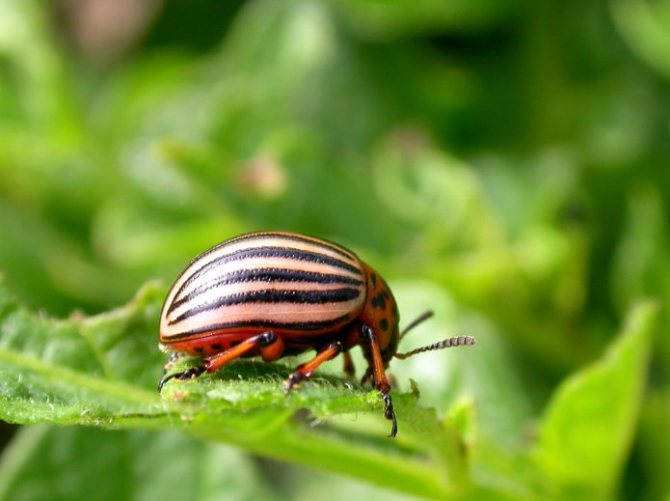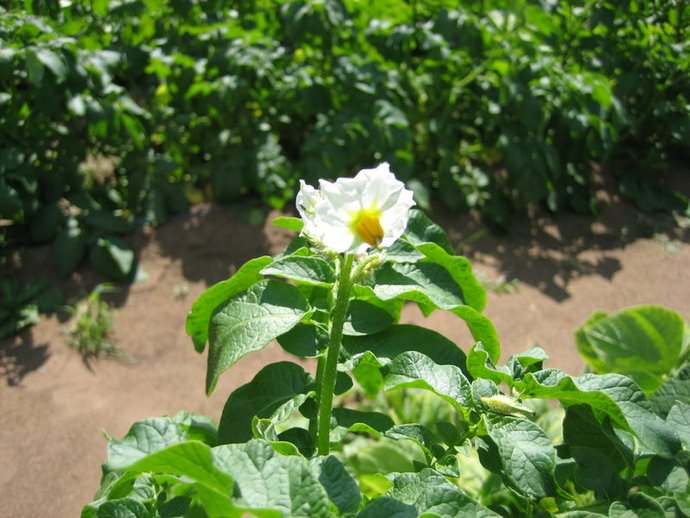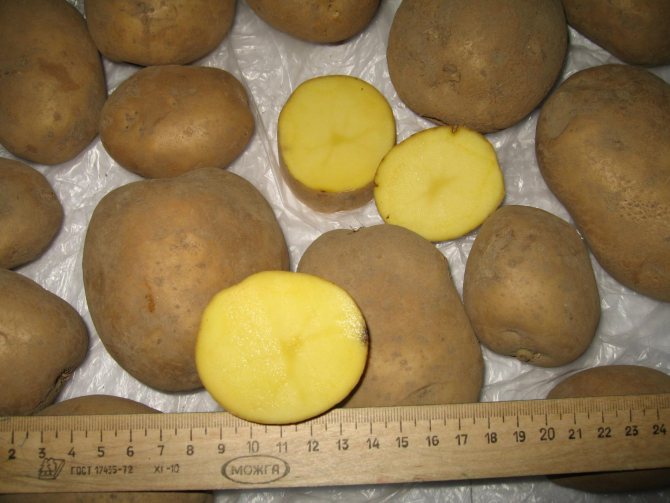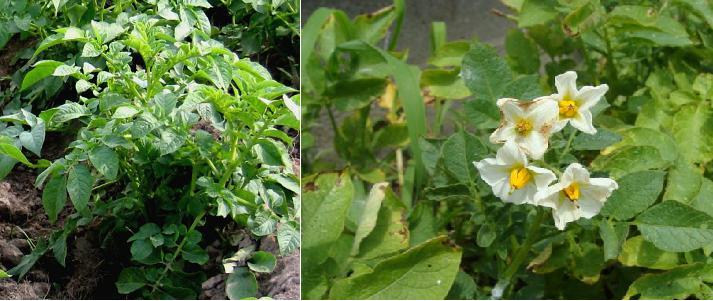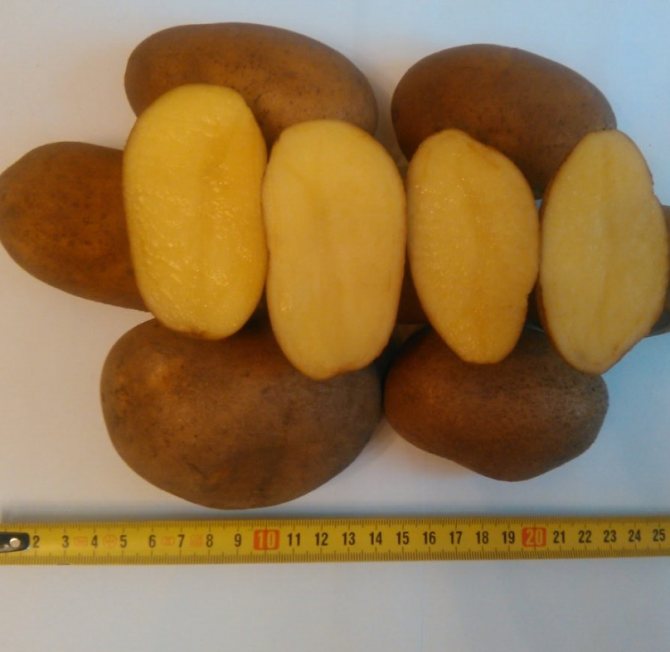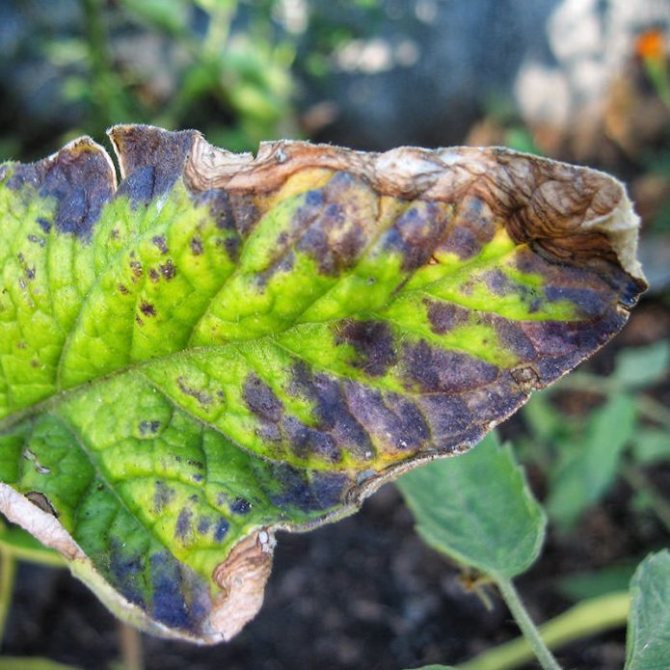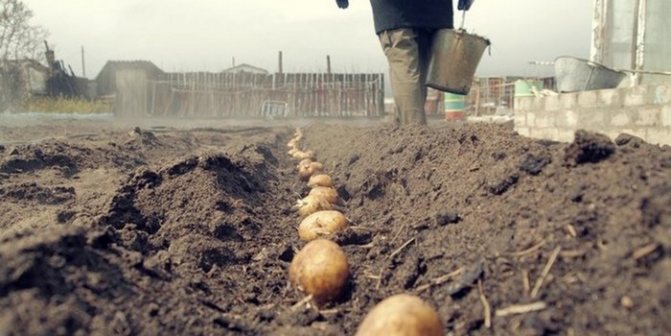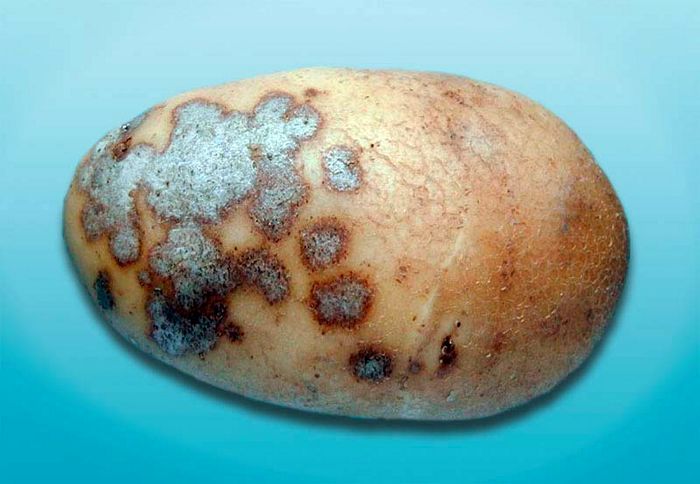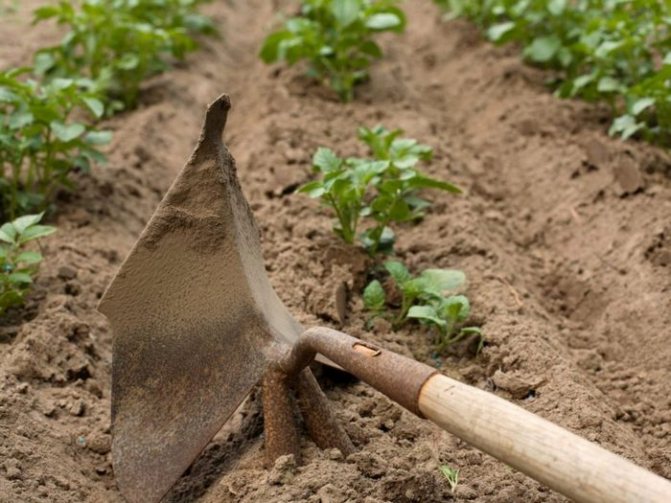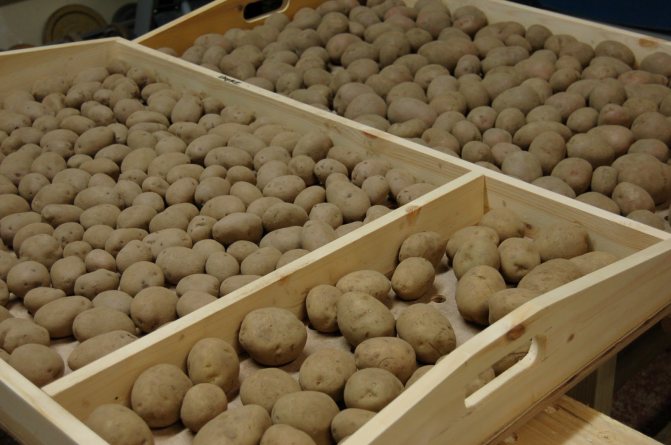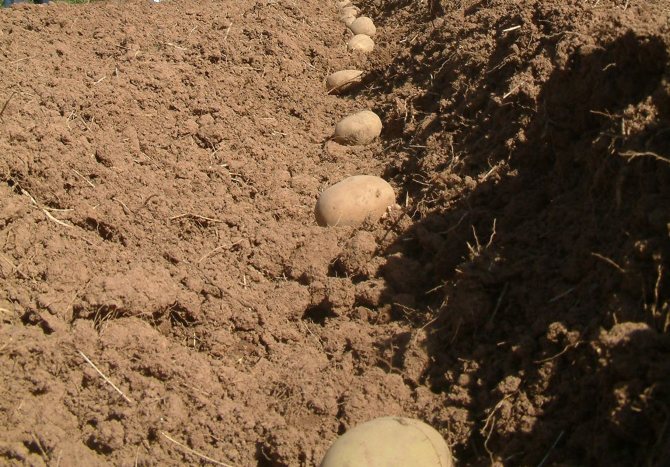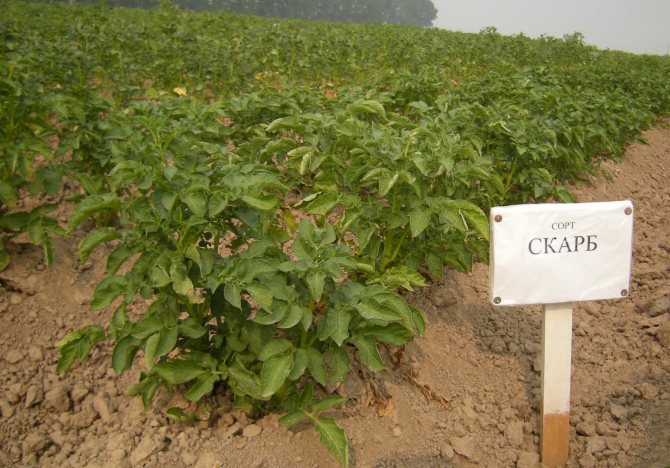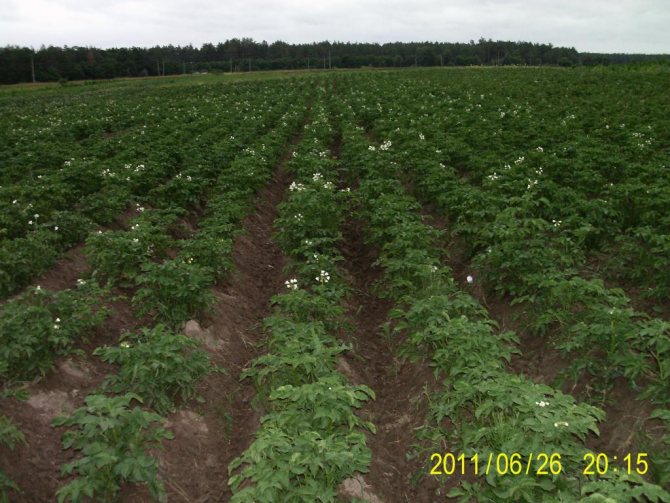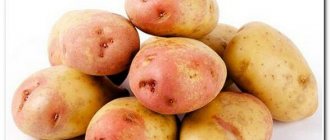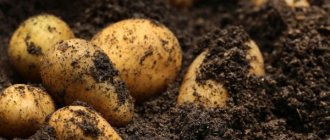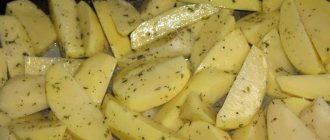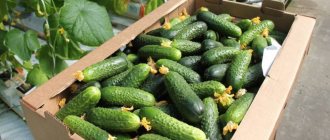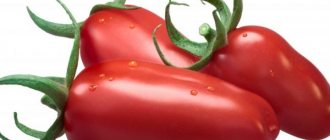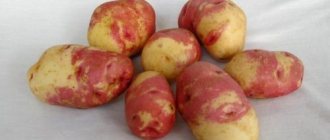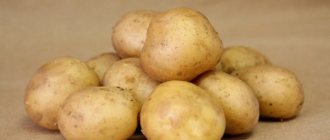Vegetable growing »Potatoes
0
1187
Article rating
The most popular vegetable crop in the world is potatoes. Residents of any country can offer national potato dishes to consumers. Therefore, neither the farms nor the owners of their own gardens refuse to grow this vegetable. Among the many varieties, you can choose those that will satisfy the highest requirements for product quality, ripening time and taste. Skarb potatoes deserve special attention, thanks to the positive reviews about it, experienced potato growers.
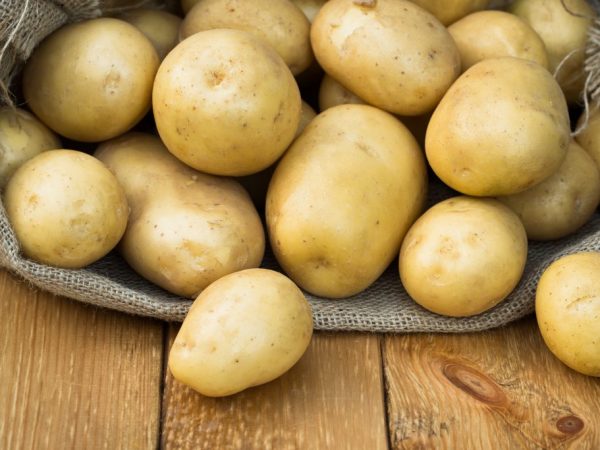
Characteristics of Skarb potatoes
Plant characteristic
This vegetable belongs to the mid-ripening species. There are many interesting things to tell about him, besides the name, which means Treasure.
- It can be grown throughout the country, except for Siberia and the Northern regions.
- On day 85, the tubers reach technical maturity.
- The productivity of the bushes is high.
- The plant is unpretentious to care for.
- The tubers are well kept and transportable.
In the central zone of the country, Skarb potatoes can give 70 tons of products per hectare, subject to all the recommendations for growing. Potatoes can bear fruit on poor soils, and they are not demanding on watering.
If the tubers are damaged during harvesting, then you need to give them time to dry the sections. These potatoes can be stored along with the rest, until the next harvest. A unique feature of potatoes is their exceptional keeping quality. Tubers, practically until next autumn, do not lose their presentation and retain all their taste.
Such products can be sold at a time when other varieties have already become flabby. The Scarb potato variety is easy to transport over long distances. In this case, the tubers are not injured and do not get dents.
Positive sides
The pluses include many indicators, along with yield.
- Scarb potatoes have excellent taste.
- The average weight of tubers is about 180g.
- The output of marketable products is up to 95%.
- Potatoes are suitable for all types of culinary processing.
- The variety is resistant to many viruses that infect nightshade crops.
A sufficiently high starch content, about 17%, prevents the vegetable from boiling and crumbling during heat treatment.
This characteristic allows boiled potatoes to be used as an ingredient in various salads. If you boil it for a long time, you can make a puree that will be lush and delicate milky.
The plant is immune to potato cancer, leaf mosaic, blackleg of stems and dry and wet fruit rot. In areas where this variety grows, golden nematodes are rarely found. But in order to completely protect your Scarb potatoes, it is not recommended to grow it for about 4 years in areas where tomatoes, peppers, pumpkins and other varieties of potatoes had previously grown.
Disadvantages of potatoes
The scourge of all nightshade crops - the Colorado potato beetle, can damage the plantings of this potato. In a rainy summer, there is a threat of damage to the stems by late blight and black leg if spores are brought in from neighboring areas. There is a partial curling of leaves and fruit scab.
Sometimes tubers get sick with ring rot. If such a phenomenon is found on them, then they become unusable.Such potatoes are also not suitable for breeding.
Some medium and late ripening varieties can be planted without prior germination. But our potato variety Scarb is necessarily germinated. Another disadvantage, but not affecting the yield, is the uneven germination and unstable flowering of the plant.
Photo
In the photo you can see the final view of the Scarb potatoes:
Due to its unpretentiousness and resistance to major diseases, grows well in almost all climates... Recommended for growing in the Volgo-Vyatka, Central and North-West regions of the Russian Federation, as well as in other countries - Belarus, Ukraine, Moldova.
The variety has a record yield, about 50-60 tons are harvested from one hectare.
Productivity is one of the main indicators of the prospects of growing a variety. In the table below you will see what this characteristic is for different varieties:
| Variety name | Yield |
| Scarb | 500-600 c / ha |
| Lorch | 250-350 c / ha |
| Hostess | 180-380 c / ha |
| League | 210-350 c / ha |
| Pretty boy | 170-280 c / ha |
| Svitanok Kiev | up to 460 c / ha |
| Borovichok | 200-250 c / ha |
| Bast | 400-500 c / ha |
| American | 250-420 c / ha |
| Colomba | 220-420 c / ha |
| Red Fantasy | 260-380 c / ha |
Excellent taste. The dormant period of the variety is 110-120 days, which allows the tubers to be stored for a very long time without losing their commercial properties. Read more about storing potatoes: dates, places, temperature, possible problems. And also how to properly store potatoes in winter, in vegetable stores, in a cellar, in an apartment, on a balcony and in boxes, in a refrigerator and in a peeled form.
Scarb is considered a mid-season variety, that is, it begins to ripen 20-30 days later than the early varieties..
Its low starch content allows it to be used for making chips, salads, pancakes and frozen vegetable mixes. The variety is moderately resistant to drought, but does not tolerate waterlogging, especially at the very beginning of growth.
It is undemanding to growing conditions, but it will grow better on heavy, fertile soils.
IMPORTANT! With timely fertilizing with mineral fertilizers, the yield and disease resistance increase significantly.
Read more about how to feed potatoes, when and how to fertilize, how to do it when planting, which fertilizers are the best.
Root crops are highly resistant to mechanical damage. Scarb is immune to potato crayfish and golden nematode, it is almost not affected by wet rot, Alternaria, Fusarium, Verticillosis, common and black scab, black leg. It is resistant to late blight of tubers, but the leaves often suffer from late blight. Ring rot can sometimes be seen.
The bush is medium in size, of an intermediate type, quite strong. The stem is thick, uncolored. The leaves are small, oval-elongated, dark green in color, open, with even smooth edges. The corolla is white, medium in size.Scarb was bred in Belarus, at the Research Institute of Potato Growing... The variety was registered in Belarus in 1997. It was officially included in the State Register of the Russian Federation in 2002.
Description of the plant
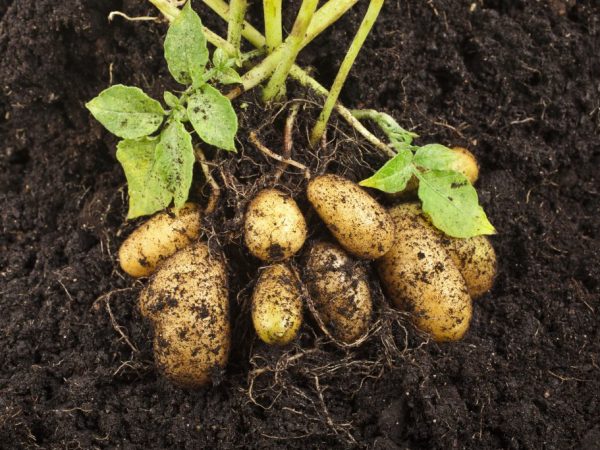

After harvesting tubers need to be dried
Scarb potatoes have semi-spreading bushes, up to 60cm high. It has up to 8 stems in each fruit nest. They are ribbed, without edges, light green in color, sometimes with yellowness.
There are many leaves on the plant, but the lower part of the stem is often bare. Potato-type leaf plate, without waviness at the edges. The veins are poorly expressed, therefore, the corrugation of the leaves is small. The color is deep green, with an excess of nitrogen fertilizers - a dark green tint.
The stems bear a simple inflorescence at the top, consisting of 10 flowers. The corollas of the flower are fused, snow-white in color. The stamens are crowded, orange. The pistil protrudes 0.5 cm above the cone of stamens. Flowers are pollinated naturally.
After pollination, the berries are partially tied, which, for the most part, crumble. About 12 green berries remain on the bushes, they can be torn off by hand. They carry few seeds. Seed fruits are poisonous. The presence or absence of berries does not affect the yield.
When growing Scarb potatoes, and considering the description of the variety, you need to pay attention to the way it is harvested. For 2 weeks, before digging out the tubers, you need to cut and remove the tops from the site.
Tubers are laid out for drying and sorted: for consumption, for planting material and separately, damaged during digging. Diseased tubers, or potatoes with suspected disease, are best destroyed.
Harvesting and storage
The optimal time for harvesting potatoes is at the end of August - beginning of September. In 15–20 days, the tops are mowed, since the peel of the Scarb tends to ripen in the soil after the aerial part of the plant is removed.
Storing Scarb potatoes involves three stages:
- Post-harvest period: culling of diseased and damaged tubers, drying and storing a new crop for 10-15 days at a temperature of 15-20 ° C.
- Main period: the variety has a uniquely long dormant period - about 120 days, due to which the potato has almost no analogues in terms of storage time. The storage temperature should be maintained within a very narrow range: for the first week up to 8–10 ° С, and then for the rest of the period within 2–5 ° С. Rapid cooling promotes long-term storage of the crop, inhibits the development of microbial spoilage.
- Spring (beginning of germination of tubers): an examination of the seed material is carried out, suitable is selected for germination.
Tubers are stored in boxes or in specially equipped bins. Storing potatoes in boxes is a priority, as it allows you to economically use storage space and monitor the condition of the tubers.
Description of tubers
Up to 15 tubers ripen in each bush. They are almost the same size and weigh from 160g to 250g. The shape is rounded oblong. The peel is smooth, without roughness and grooves. The color of the peel is uniformly golden or deep yellow.
The eyes are evenly spaced over the entire surface of the tuber. Their good feature is that they do not germinate when stored in basements. But this property obliges gardeners to warm up the tubers before germination.
The sugar content of the potatoes is about 0.4%, which gives a sweetish taste. Dry matter in potatoes is more than 20%. This allows crispy fries and chips to be cooked.
General information
Skarb potatoes (description of the variety, photos, reviews - information that this article contains) was bred by the efforts of breeders from Belarus. The name means belongings, that is, property, which is the main meaning of the word "belongings". In translation it is interpreted as "treasure", "wealth", "treasure". The variety was bred at the end of the last century, in Russia it was allowed for cultivation in 2002 after it was included in the State Register of our country. Potatoes are recommended for growing in many regions. It is widespread in Belarus itself, in the vast expanses of Ukraine and in Moldova.
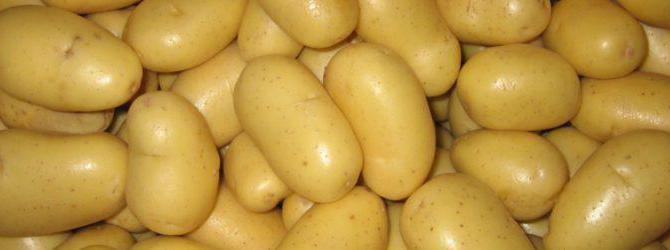

Preparing the soil for potatoes
The description and characteristics of the crop says that this variety can be grown on almost any soil. But in clay areas, ridges are formed, into which a well-rotted mullein is added. This improves the structure of the soil, from heavy soil to loose soil.
In other vegetable gardens, green manures such as mustard and barley can be planted in early autumn. With a growth of about 30 cm, they are embedded in the ground when digging. Instead of siderates, up to 45 buckets of humus are brought in for 1 hundred square meters, leveled and dug deeply.
Ammonium nitrate, superphosphate and wood ash are scattered in the spring.It is possible, on the surface of the soil before filling the holes, but it is better to bring directly into the planting holes. Then the plant will immediately receive nutrients.
From the history of the Scarb potato variety
Scarb was introduced by RUE "Scientific and Production Center of the National Academy of Sciences of Belarus for Potato and Horticulture", included in the State Register of the Republic of Belarus in 1997, and in 2002 - in the State Register of the Russian Federation, which gives the right to multiply, import and sell seeds and planting material. The variety is patented, recommended for cultivation in the North-West, Central and Volga-Vyatka regions of Russia.
Scarb's tubers are oval-round, large, yellowish in color, with small eyes
Seed preparation
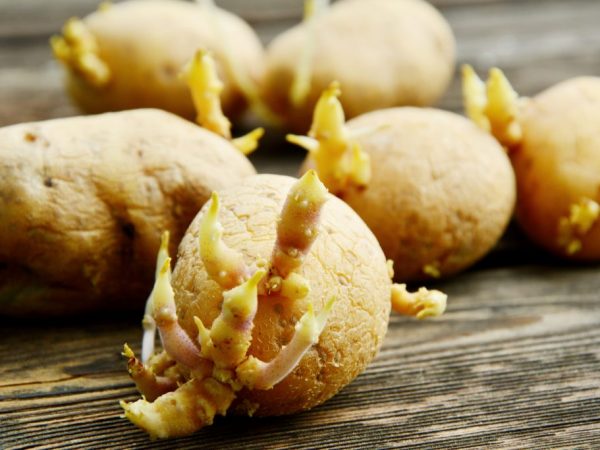

Tubers for planting must be healthy
A month before warm weather sets in, tubers are taken out of the basement. Potatoes cooked in the fall are again carefully inspected for dry or wet rot, scab and visible damage. For planting, completely healthy tubers are selected, preferably of the same size.
They are heated at a temperature of about 35 ° C throughout the day. Then they are laid out in one layer in boxes and exposed to light at room temperature for germination and gardening. After the sprouts reach a height of 3.5 - 4 cm, they can be planted. Before planting, treatment with Prestige is recommended
Planting tubers
When the weather is warm and the ambient temperature is at least 15 ° C, and the soil is at least 10 ° C, you can start planting. If necessary, they form ridges up to 30 cm high and arrange them from north to south. This arrangement, both of the ridges and rows, will serve to better warm up the rows and illuminate the bushes. The width between them is allowed 60cm. They dig planting holes with a depth of about 10 cm and a distance, one from another, no more than 25 cm.
Mineral fertilizers are added to the wells, in a teaspoon:
- superphosphate;
- potassium salt;
- potassium chloride.
You can also put handfuls of onion husks and wood ash. In vegetable gardens, in pits, you need to put potatoes, strong sprouts up, and carefully, so as not to break them, fill them with soil.
Description of planting and care
Like any potato, it is preferable to grow the Scarb variety in sunny areas with light fertile soils. When shaded, the tops are strongly stretched, which is why the potatoes tie a limited number of tubers, since the juices go into the green mass. The acidity of the soil should be close to neutral.
Site selection, soil preparation and planting material
All weeds are removed from the site, organic fertilizers are applied (at the rate of 5–6 kg per 1 m2). Before persistent frosts, the soil is plowed or dug up to at least the depth of a shovel's bayonet: this will greatly reduce the number of pests in the soil. In the spring, loosening of the soil is carried out, the marking of future ridges.
The introduction of wood ash into planting ridges or holes has a very good effect on the quality and quantity of the crop: it serves as an excellent mineral fertilizing and at the same time has a detrimental effect on overwintered pests. However, it is undesirable to overdo it with the introduction of organic matter: in potatoes, due to an excess of nitrogen in the soil, the growing season is extended, the ripening period of the crop is postponed, and there is also a threat of accumulation of an increased amount of nitrates in the tubers.
Seed tubers require germination before planting:
- Seed potatoes are cooked 20-25 days before the planned planting date. The planting material selected in the fall is carefully examined in order to reject damaged and diseased tubers.
- Seed potatoes are laid out in one or two layers on a flat surface or in wooden boxes. The latter option is preferable, since the boxes can be stacked on top of each other in order to save space.
- Every other day, sprouting sprouting potatoes with plain water is carried out to prevent them from drying out.
- At first, the temperature in the room is maintained within the range of 18–22 ° С, and then it can be reduced to 10–14 ° С.
- A day or two before planting, the tubers are treated with a joint weak solution of potassium permanganate and copper sulfate to improve potato resistance to infectious agents.
- Tubers are considered ready for planting if they have strong green shoots one to two centimeters long.
It must be remembered that the most productive in terms of yield are the first shoots. If such a sprout is accidentally damaged, after a while it will be replaced by a "spare" bud. The sprout that has grown instead of the broken off will be less productive.
If tubers for planting are taken directly from the cellar and immediately embedded in the soil, the eyes will begin to germinate only after 10–12 days, and after another two weeks, shoots will appear. Therefore, the potatoes must be germinated before planting. Thanks to germination, the growing season for plants is much longer, they make better and fuller use of the May and June sun, which is rich in ultraviolet rays, and suffer less from summer heat and drought.
V. SHAIKIN, Candidate of Agricultural Sciences.
Feature of the Scarb variety: categorically does not tolerate cutting the tuber into pieces (in order to increase the amount of planting material) - the eyes stop growing together.
Schemes and timing of planting potatoes
When choosing the distance between the ridges and the planting density in the rows, first of all, they are guided by the size of the tubers and the composition of the soil. The finer the planting material, the smaller the distance between the holes; the more fertile the land, the less frequent the planting pattern. So, for planting material with an average weight of 50-60 grams, depending on the soil, the following schemes and planting depth will be optimal:
- light soils with an average humus content - 60 × 25/60 × 30 cm to a depth of 10–12 cm;
- loams and heavy fertile soils - 65 × 30/60 × 35 cm to a depth of 8–10 cm;
- clay soils - 70 × 30/70 × 35 cm to a depth of 4–5 cm.
The main criteria when choosing the timing of planting potatoes are weather conditions and soil temperature. The land should warm up to 7–8 ° С with a depth of the arable layer of 10–12 cm, and the average daily temperature should not fall below 8 ° С.
Table: cultivation techniques (watering, loosening, top dressing) of Scarb potatoes
| Event | Purpose of the event | Deadlines |
| First watering + application of ammonium nitrate at the rate of 15–20 grams per 1 m2 | Ensure the survival rate of planting material | The day after landing |
| Soil harrowing | Crust breaking, suppression of emerging weeds | After the soil has dried |
| Hilling rows (carried out on a cloudy time of day) | Increase root formation | Plants have reached a height of 14-18 cm |
| Irrigation with the introduction of mineral fertilizers | Maintaining soil moisture, plant feeding | The beginning of flowering potatoes |
| Second hilling rows | Final formation of ridges | Two to three weeks after the first hilling |
| Third watering + enhanced potassium-phosphorus feeding (150 g of potassium monophosphate per 10 liters of water) | Provide normal plant nutrition | After the end of flowering |
Growing features
Due to the fact that the tubers of the Skarb variety begin to form close to the surface, hilling is carried out high and at least three times per season. This measure will prevent greening of the tubers located at the very surface. If, nevertheless, greening has occurred, then such tubers are used strictly for planting. Such potatoes are not suitable for food or pet food because of the toxic substance solanine formed in them.
To obtain the same seedlings, it is necessary to adhere to the same planting depth of tubers, taking into account the type of soil. On heavy loamy soils with a critical level of groundwater, potatoes are planted in ridges.This will reduce the risk of its infection with rhizoctonia and to some extent protect the potato plot in case of its flooding by groundwater. In arid regions, for all types of soils, a smooth planting of 8–10 cm is preferable. In this case, much less ground moisture is lost.
Growing potatoes
After the first shoots appear, and they germinate unevenly, the bushes slightly huddle, protecting the plants from night frosts. Further planting care comes down to such activities as:
- watering;
- weeding and loosening;
- fertilizer;
- prevention of viruses and diseases;
- insect control.
Plants need to be watered at least 3 times during the entire growing season. If the summer is rainy, then they are limited to loosening the soil and weeding. Weeds must be removed carefully to avoid injury to young tubers that are located in the top layer of the soil.
Advantages and disadvantages
Potatoes Kumach
The Scarb variety has its own strengths and weaknesses. The undoubted advantages include:
- stable yield;
- high profitability for industrial planting;
- excellent taste characteristics;
- early ripening of tubers;
- adaptability to various weather conditions;
- long shelf life without loss of presentation and taste.
The disadvantages are usually noted:
- insufficient resistance to late blight;
- inhibition of development with excessive soil moisture.
It should be noted that the negative aspects of the variety begin to manifest themselves only if the plant is not provided with normal care. If agricultural technology is fully followed, there are no problems with the potato variety.
Disease and insect control
In order not to have to treat diseased plants, it is better to first carry out preventive treatment of the bushes. From the occurrence of late blight of the stems, the bushes will protect 1% solutions of Bordeaux mixture or copper sulfate. Process them by spraying. The appearance of a black leg will stop spraying the plantings with a 3% manganese solution or trimming them with ash.
The Colorado potato beetle can be harvested by hand, and after the massive appearance of the larvae, biological preparations such as Bitoxibacillin and Fitoverm are used. Of insecticides, Aktara, Corado and Confidor are suitable.
From the wireworm, they are treated with Provotox, and from the bear - Medvetox or Grizzly. The moth caterpillar is destroyed by the biological substance Nemabakt.
Possible diseases and pests
Scarb potatoes are distinguished by their resistance to defeat by many ailments characteristic of the culture. However, tubers can still be subject to some diseases.
Table: diseases peculiar to the Scarb variety
| Diseases | Signs of defeat | Treatment methods | Prophylaxis |
| Late blight |
|
|
|
| Ring rot |
| No means of control have been developed, therefore, ring rot is classified as a quarantine disease. |
|
Photo gallery: ailments typical of potatoes
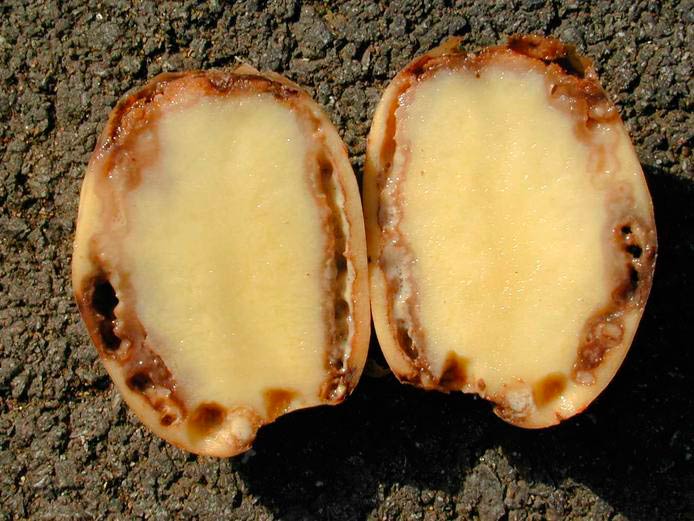

Ring rot can rob most of the crop
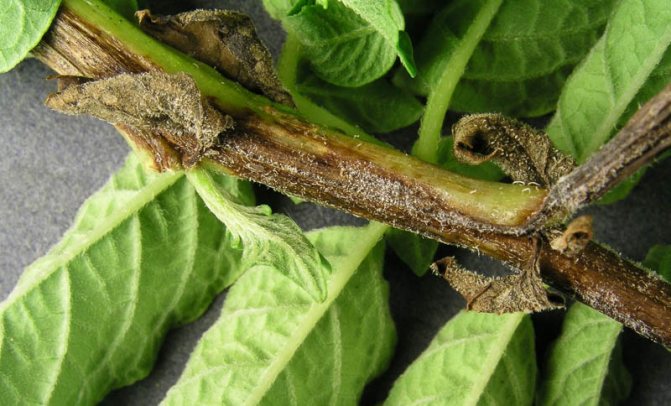

Stems affected by late blight rot
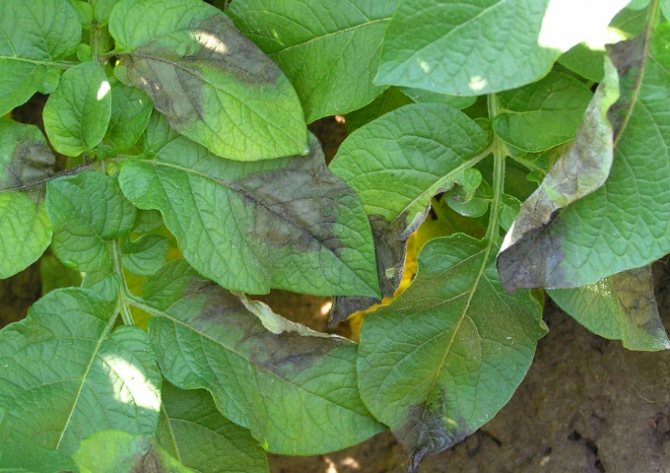

Late blight begins to spread from leaves
Table: potato pests
| Pests | Signs | Ways to fight | Prevention measures |
| Colorado beetle | The pest affects the tops of potatoes. The larvae gnaw the leaves completely, leaving only veins. | Spraying with a solution of Boverin (50 g per 10 l of water) or Bitoxibacillin (50 g per 10 l). | Selection of healthy root crops for planting, loosening of row spacings, hilling, destruction of tops. |
| Wireworm | The pest makes moves in the tubers. | Spraying with Tabu insecticide (8 ml per 1 liter of water). | Loosening the soil and removing weeds. |
| Cicadas | Insects attack the outside of the leaves, causing the tissue to dry out. | Destruction of the ground part of the potato bushes. |
Photo gallery: insects attacking potatoes
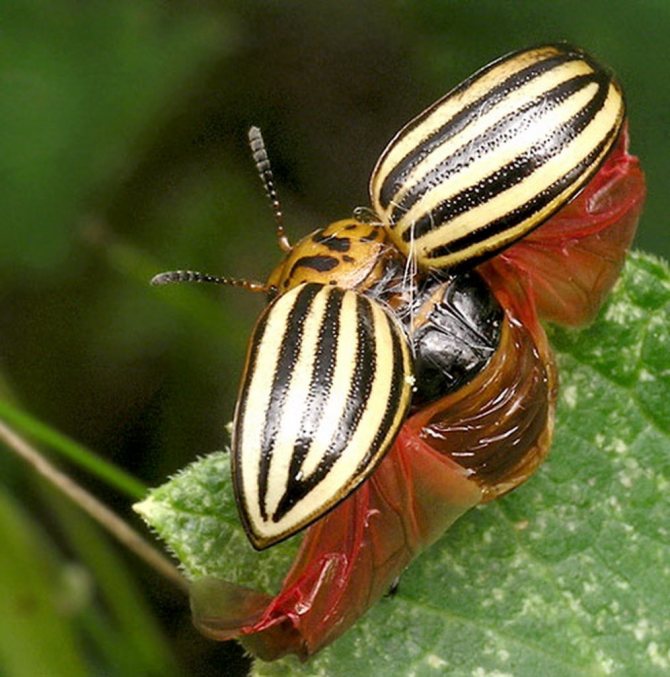

Colorado potato beetle quickly eats bush leaves


Wireworm significantly impairs the quality of tubers
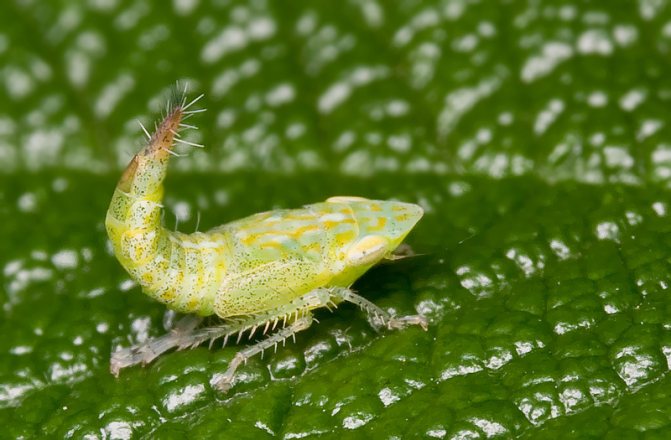

Leafhoppers cause leaves to dry out
How to choose a landing site?
Scarb potatoes (description of the variety, photos, reviews, read and see in the article) is an unpretentious variety, but it has its own preferences. The best place for its growth is considered to be small slopes facing south. If it is not possible to choose a bed in this place, you can use the southwest direction to determine the area for potatoes. In these places, the lighting is organized correctly and there is no stagnation of water.
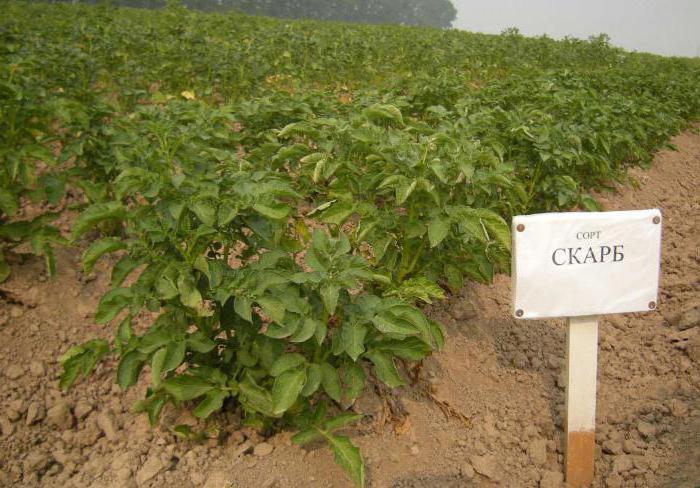

When choosing a site, it is important to consider potato preferences. Sandy loam and loamy soils are comfortable for him. Feels good in black earth and peat soils. But you can not wait for fruiting if you plant potatoes in a heavy substrate, characterized by constant stagnation of moisture.
Proper watering
Potatoes of the Belarusian selection Skarb respond well to properly organized agricultural technology, although they are unpretentious and bear fruit well not only among experienced vegetable growers, but also among novice gardeners. One of the important and necessary procedures is watering. Scarb potatoes need it at different stages of growth and formation. Watering should be carried out regularly during the growing season and the formation of root crops. If the weather is cloudy, the procedure is performed once every ten days. On sunny days, this is done more often, after three to five days. 15 liters of water are consumed per square meter of garden area.
Fertilizers
Along with watering, high quality fertilizers are applied. A good effect is given by feeding plants with nitrofosky and nitroammophos, respectively, five and three kilograms per hundred square meters. Scarb potatoes respond very well to fertilization. According to the reviews of experienced farmers, such an organic additive as chicken manure has proven itself well. It contains substances that have a quick effect on the plant, due to which the potato bushes begin to develop intensively.

